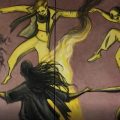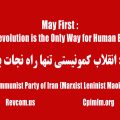TWO NOTES: 1. What Is the Nature of “Amnesty”? ۲. The Dialectical Synergy between Sheikh [Mullah] and Shah [Monarchy]
by Setareh Mehri
March 20, 2023
Editors’ Note: The following is a translation of an article from the Communist Party of Iran, Marxist-Leninist-Maoist (cpimlm.org), which appeared in their journal Atash/Fire, No. 136, March 2023. This translation, excerpts and bracketed explanatory notes from the original article are by revcom.us volunteers.
۱. What Is the Nature of “Amnesty”?
The Islamic Republic responded to our five-month uprising with suppression followed by “pardoning” of political prisoners and promises of “reforms” from the mouths of conniving reformists [i.e. a faction within Iran’s regime who thinks the IRI can be changed for the better or fixed]. The announcement of “amnesty” in the middle of the uprising is an attempt within the framework of a macro policy of continuing repression and risk management, with the aim of saving the system as a whole and a return to “normal operations.”
A Policy with Multiple Goals and Audiences
On the one hand, [the IRI’s] amnesty aims to hide their fear of the power of the people’s uprising and to create a possible split within the ranks of the struggle, by putting a “benevolent” face on the Islamic Republic. On the other hand, it aims to create more unity among various factions inside and outside of the system. At the same time, and perhaps most importantly, [the amnesty] is an effort to demonstrate readiness for some kind of compromise with the western imperialist powers while maintaining some form of the Islamic Republic in power. It’s a hideous and disgusting attempt to tell the people: “Look out! This regime is not going anywhere! But it will offer amnesty!” And it communicates to the international community [i.e. imperialists], “We will grant [some] amnesty provided that you don’t kick us out of the game!”
The Islamic Republic wants to cover up the role of the recent people’s five months of struggle and resistance for freedom …with the obscene word “amnesty,” to say that even though their power has suffered some hits, it is still functioning. Nasser Mohajer۱, a researcher of the history of Iran’s prisons, rightly said, “Using the word ‘pardon’ is a bit of a joke and a deception, part of the government’s demagogic policy. The fact is that a number of political prisoners have [already] been acquitted.” (Nasser Mohajer, interview with Aida Ghajar, February 11, 2023).
Despite continuing resistance, the ebbing of the uprising is real and quite a natural matter, for the simple reason that people cannot fight at the same tempo forever. The Islamic Republic, energized by this ebb, is trying to recover from its crisis by making some superficial changes. They integrate “reforms” into their project, giving people just a drop of water, as they take a raging river away from them, and integrate “the reformists” into their project.
It is clear that the Islamic Republic will not simply give up power. In the same interview, Nasser Mohajer correctly emphasizes that “in this battle and the society’s protest against the Islamic Republic, we must not forget that systematic repression continues to have the power to act.”
We should remain alert to this understanding. Many well-known political prisoners and many unknown political prisoners in small towns have not yet been released…. The arrest of the Baha’is [members of a religious group] continues. Environmentalist prisoners are in danger. Under these circumstances, we must expand the global movement for “the immediate release of political prisoners,” more than ever. The movement against torture, arrests and executions must be brought into the attention of people all over the country and around the world—each and every one of the crimes committed by this regime during the “Gina uprising.” We must continue to intensify these exposures and we must struggle to hold the Islamic Republic accountable for its crimes. We should never forget the murder of over 500 people, the wounding or blinding of thousands of people, the imprisoning of 30,000 young people. We must not forget that “cruelty and sexual violence in Islamic Republic prisons … has never been seen on such a scale….” (Nasser Mohajer, Ibid.)
۲. The Dialectical Synergy Between Sheikh [Mullah] and Shah [Monarchy]
AS IRAN’S UPRISING EBBS, REZA PAHLAVI & CO. BECOME MORE ACTIVE
The struggle against the Islamic Republic is a complex and multifaceted scene, with a variety of actors. As the popular struggles against the regime intensified in recent months, it became necessary to more actively confront other forces in the field. The U.S. and European imperialists are forced to act with urgency in response to their own necessity regarding the future of Iran. This is in fact the future of their hegemony in the Middle East. And, they are searching for opportunities to impact the direction of Iran’s future.
This is why various “alternatives” are being moved here and there like chess pieces on their game board. With one hand, they move the Reza Pahlavi & Company piece. Then with the other hand they hold an online meeting between Maryam Rajavi of the People’s Mojahedin Organization of Iran [MEK] and more than 160 members of the U.S. Congress, who present a resolution to the U.S. Congress supporting her/MEK.۲ Moving these chess pieces, cloaked in whatever manner, under whatever auspices is the expression of an acute class struggle—a struggle that, ironically, tries to cover up its class nature by promoting a variety of political forces. The foundational supporters of these imperialist alternatives are mainly from the middle class and aspire to enjoy the same type of parasitic prosperity in Iran that is enjoyed by a section of the population in imperialist countries—namely the type of parasitic welfare that imperialism funds by plundering the countries of the “global South.”
The clash between these two trends (the Islamic Republic on the one hand, and the imperialist alternatives on the other) is contradictory. Both of them represent obsolete and decaying strata. In fact, in them we can see the dynamics of the “two outmodeds”۳ magnified: more Shah/King, more Sheikh/Mullah! The Islamic Republic is acutely aware of this dialectic and is trying to use it and try to redirect the groups that have “fallen away” from it, and specifically the “reformists,” and push them towards the Islamic Republic’s project to consolidate and restore power…



